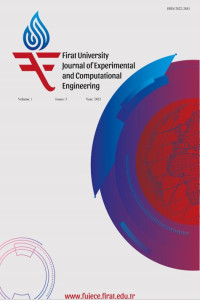Öz
Kaynakça
- [1] Rao SS. The Finite Element Method in Engineering, 2nd ed. Pergamon Press, Oxford, U.K. 1982.
- [2] Rao SS. Finite Element Method in Engineering. 2nd and 3rd ed. 1992.
- [3] Zienkiewicz OC. The Finite Element Method, 5th ed. (volume 1) The Basic, 2000.
- [4] Van Dyke M. Perturbation Methods in Fluid Mechanics. Academic Press, 1964.
- [5] Ahmed T and McKinney P. Advanced reservoir engineering. Gulf Professional Publishing, Oxford, 2011.
- [6] Lee WJ. Pressure transient testing part 9. Production engineering methods. In: Development Geology Reference Manual. AAPG Methods in Exploration No. 10, Tulsa, OK, 477-481, 1992.
- [7] Chakrabarty C, Ali S, Tortike W. “Analytical solutions for radial pressure distribution including the effects of the quadratic gradient term”. Water Resour Res, 29(4), 1171-1177, 1993.
- [8] Van Everdingen A. “The skin effect and its influence on the productive capacity of a well”. J Petrol Techn., 5(06), 171-176, 1953.
- [9] Barreto AB, Peres AM. “A variable-rate solution to the nonlinear diffusivity gas equation by use of green’s-function method”. SPE Journal, 145468, 2012.
- [10] Couto P, Marsili MD. “A general analytic solution for the multidimentional hydraulic diffusivity equation by integral transform technique”. Rio de Janeiro, Brazil, OTC, 29-31, 2013.
- [11] Wu YS, Li J. “A generalised framework model for the simulation of gas production in unconventional gas reservoirs”. SPE Journal, 163609, 2014.
- [12] Folade OA, Chukwunagolu VS. “Homotopy Analysis Solution to Radial Diffusivity Equation of Slightly Compressible Fluid”. Appl. Maths., 7(9), 93-1004, 2016.
- [13] Reza A, Mohamad M, Zahra S. “Parametric analysis of diffusivity equation in oil reservoirs”. J Petrol Explor Prod Technol, 6, 1-11, 2016.
- [14] Christine, AE. Well test analysis for wells produced at constant pressure. PhD thesis submitted to the Department of Petroleum Engineering and the Committee on Graduate Studies of Stanford University, 1979.
Numerical determination of the production rate and cumulative production in the constant pressure outer boundary condition
Öz
The flow regime is identified as a steady-state flow if the pressure at every location in the reservoir remains constant. In this work, we have determined the well production rate and cumulative production in a circular reservoir using the Finite Element Method for the condition of constant pressure outer boundary. The reservoir was divided into 4 smaller part known as finite element. These parts were analyzed and later assembled to form the domain of the reservoir. The analysis was done with the assumption that before the well begins production, there was uniform distribution of pressure all through the reservoir. The results obtained from the production rate analysis shows that the dimensionless production rate decreases significantly and later becomes uniform because the withdrawn fluid has been completely replaced. This condition remains throughout the entire life of the reservoir presumably. Also, the result shows that there is a uniform increase in the dimensionless cumulative production as time increases. The result obtained in this work was compared with the results obtained by previous researcher. The comparison shows a strong positive correlation between the two methods with a maximum percentage error of 0.1711 and 0.1864 and a minimum percentage error of 0.0001 and 0.0122 for dimensionless production rate and dimensionless cumulative production respectively. Also, result from previous researcher only state the production rate and cumulative production of the reservoir at a particular time but this work predicts the production rate and cumulative production in the entire reservoir at the same time.
Anahtar Kelimeler
Diffusivity equation Boundary condition Cumulative production Production rate Finite element method.
Teşekkür
We want to acknowledge the Department of Production Engineering, University of Benin, Nigeria for serving as a platform to embark on this research.
Kaynakça
- [1] Rao SS. The Finite Element Method in Engineering, 2nd ed. Pergamon Press, Oxford, U.K. 1982.
- [2] Rao SS. Finite Element Method in Engineering. 2nd and 3rd ed. 1992.
- [3] Zienkiewicz OC. The Finite Element Method, 5th ed. (volume 1) The Basic, 2000.
- [4] Van Dyke M. Perturbation Methods in Fluid Mechanics. Academic Press, 1964.
- [5] Ahmed T and McKinney P. Advanced reservoir engineering. Gulf Professional Publishing, Oxford, 2011.
- [6] Lee WJ. Pressure transient testing part 9. Production engineering methods. In: Development Geology Reference Manual. AAPG Methods in Exploration No. 10, Tulsa, OK, 477-481, 1992.
- [7] Chakrabarty C, Ali S, Tortike W. “Analytical solutions for radial pressure distribution including the effects of the quadratic gradient term”. Water Resour Res, 29(4), 1171-1177, 1993.
- [8] Van Everdingen A. “The skin effect and its influence on the productive capacity of a well”. J Petrol Techn., 5(06), 171-176, 1953.
- [9] Barreto AB, Peres AM. “A variable-rate solution to the nonlinear diffusivity gas equation by use of green’s-function method”. SPE Journal, 145468, 2012.
- [10] Couto P, Marsili MD. “A general analytic solution for the multidimentional hydraulic diffusivity equation by integral transform technique”. Rio de Janeiro, Brazil, OTC, 29-31, 2013.
- [11] Wu YS, Li J. “A generalised framework model for the simulation of gas production in unconventional gas reservoirs”. SPE Journal, 163609, 2014.
- [12] Folade OA, Chukwunagolu VS. “Homotopy Analysis Solution to Radial Diffusivity Equation of Slightly Compressible Fluid”. Appl. Maths., 7(9), 93-1004, 2016.
- [13] Reza A, Mohamad M, Zahra S. “Parametric analysis of diffusivity equation in oil reservoirs”. J Petrol Explor Prod Technol, 6, 1-11, 2016.
- [14] Christine, AE. Well test analysis for wells produced at constant pressure. PhD thesis submitted to the Department of Petroleum Engineering and the Committee on Graduate Studies of Stanford University, 1979.
Ayrıntılar
| Birincil Dil | İngilizce |
|---|---|
| Konular | Makine Mühendisliği |
| Bölüm | Araştırma Makalesi |
| Yazarlar | |
| Yayımlanma Tarihi | 28 Ekim 2022 |
| Yayımlandığı Sayı | Yıl 2022 Cilt: 1 Sayı: 3 |
Kaynak Göster
Bu eser Creative Commons Atıf-GayriTicari 4.0 Uluslararası Lisansı (CC BY NC) ile lisanslanmıştır.

